5 Common Branding Mistakes Small Businesses Make
And How to Avoid Them
Branding isn’t just about having a nice logo or a trendy color palette. For small businesses, your brand is how people recognize you, remember you, and decide whether they trust you. But many small businesses unintentionally make branding mistakes that weaken their presence, confuse their audience, or slow their growth.
Here are five of the most common branding mistakes small businesses make, and how to avoid them.
1. Treating Branding as Just a Logo
The mistake:
Many businesses think branding stops at designing a logo. They might use the logo on their business cards and website — and call it a day.
Why it hurts:
Without a full visual identity system (fonts, colors, layout, tone, etc.), your brand ends up looking inconsistent and unprofessional across touchpoints.
How to avoid it:
Think beyond the logo. Build a complete brand identity including:
- A defined color palette
- Typography hierarchy
- Imagery and icon styles
- Voice and tone
- Clear usage guidelines
A consistent system builds recognition and trust.
2. Inconsistency Across Platforms
The mistake:
Using different visuals, tones, or messaging on your website, social media, packaging, and emails.
Why it hurts:
People see your brand in many places. If your Instagram feels fun and casual but your website is cold and corporate, it creates confusion — and confusion kills trust.
How to avoid it:
Create a brand guideline (even a simple one) and stick to it. Use the same logo version, fonts, colors, and messaging style across all platforms. Your brand should feel like one voice, no matter where it's seen.
3. Following Trends Too Closely
The mistake:
Chasing the latest design trends just to look “modern” , even if they don’t fit your brand’s personality or audience.
Why it hurts:
Trendy design can make your brand feel generic or outdated fast. Worse, it can send the wrong message about who you are.
How to avoid it:
Build your brand based on your identity, not just aesthetics. Ask:
- Who is my audience?
- What values do I want to communicate?
- What tone fits my industry?
Trends can inspire, but your brand should be timeless and authentic.
4. Not Understanding the Target Audience
The mistake:
Designing a brand based on what you like, not what speaks to your audience.
Why it hurts:
Your brand isn't for you, it's for the people you want to attract. If you don’t align your visual language with their tastes, needs, and values, they’ll move on.
How to avoid it:
Start with research. Understand:
- Who are your ideal customers?
- What do they care about?
- What visuals, language, or tone connect with them?
Design your brand to attract and connect, not just to look good.
5. Skipping Professional Help
The mistake:
Trying to DIY your branding using free tools or quick logo generators.
Why it hurts:
While this can be a budget-friendly start, DIY branding often lacks strategy, flexibility, and polish. It may work short-term, but it won’t grow with your business.
How to avoid it:
If possible, work with a professional brand designer who can:
- Understand your business goals
- Create a strategic, tailored identity
- Deliver a complete toolkit for consistent use
It’s an investment that pays off in trust, recognition, and growth.
Final Thoughts
Branding isn’t just how your business looks, it’s how it’s remembered, trusted, and talked about. By avoiding these common mistakes, small businesses can build stronger, clearer brands that actually support their growth.
If you're ready to refine your brand, or build one from the ground up, I’d be happy to help.
Let’s create something bold, smart, and uniquely yours.


